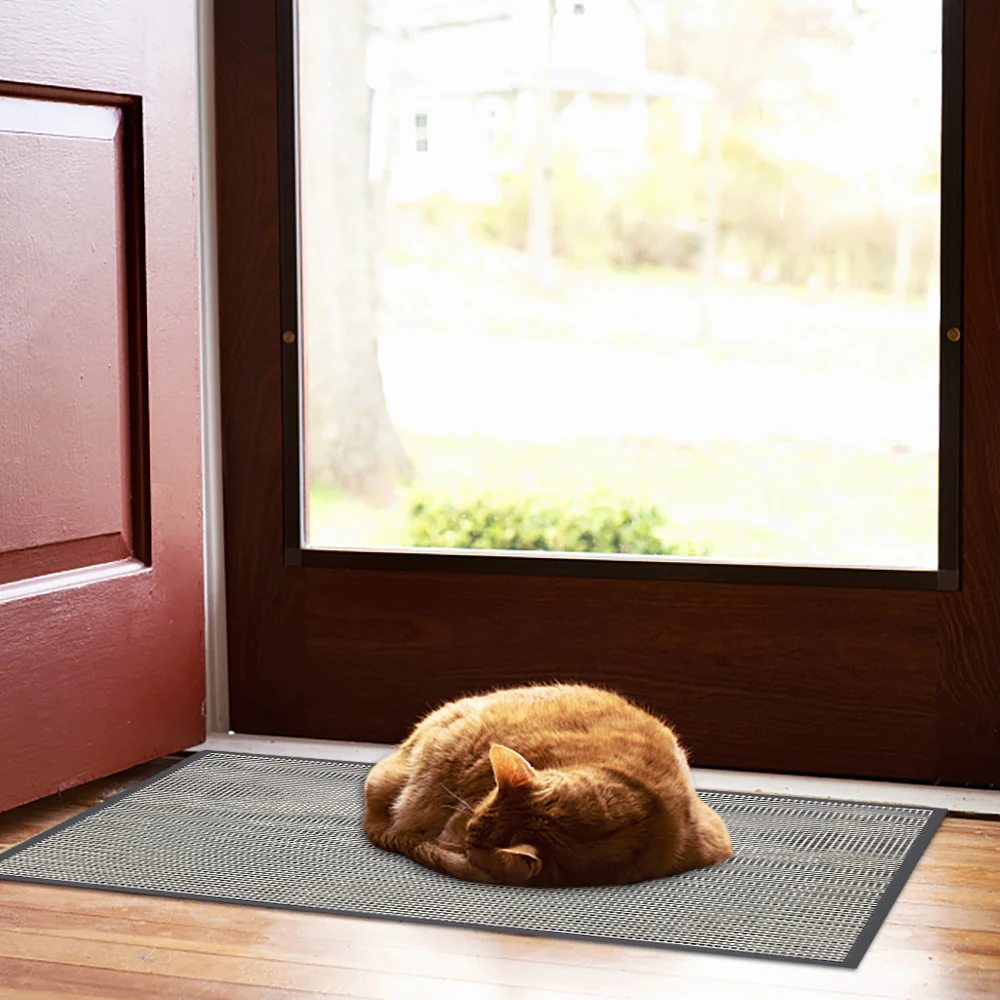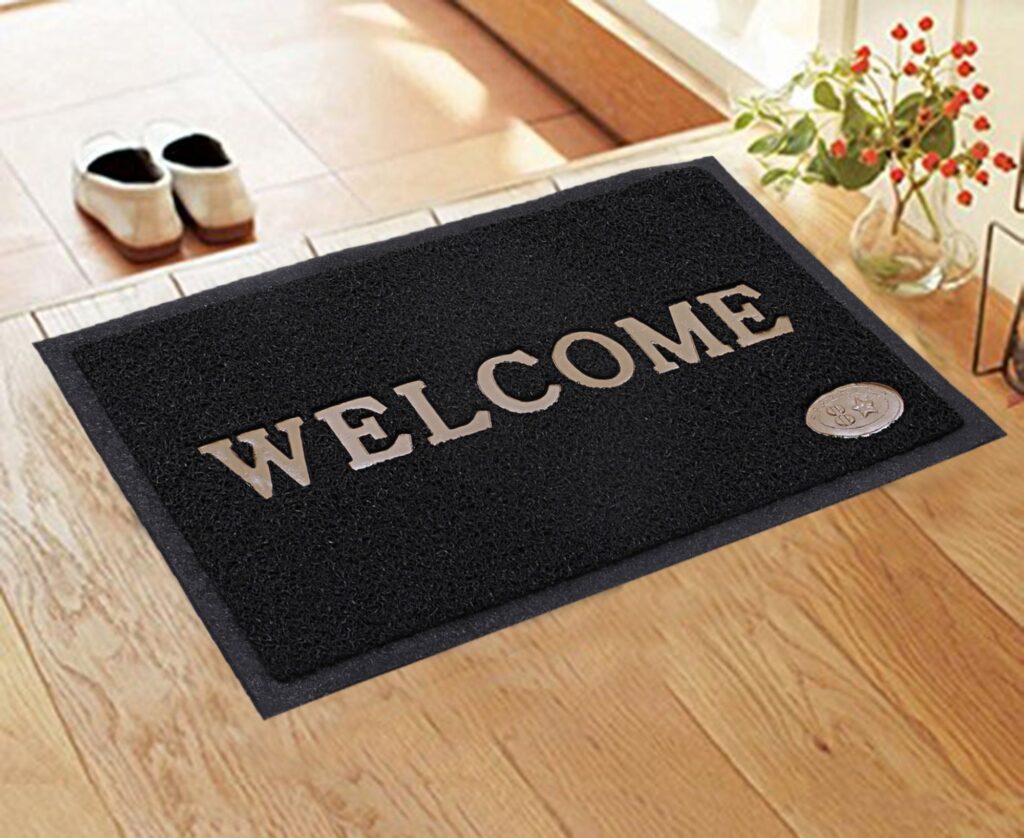Door mats are simple yet effective tools that offer many benefits to households and businesses. Here are some of the benefits of using a door mat:
- Keeps floors clean: A door mat traps dirt, mud, and debris from shoes before they enter your home or business. This helps to keep floors clean and free from dirt and dust.
- Reduces cleaning costs: By trapping dirt and debris, a door mat helps to reduce the amount of dirt that is tracked into a building. This reduces the need for cleaning and maintenance, which can save money in the long run.
- Prevents slips and falls: A wet or slippery floor can be dangerous, especially in areas with high foot traffic. A door mat helps to prevent slips and falls by absorbing moisture and providing a non-slip surface.
- Protects flooring: High traffic areas can quickly wear down flooring, leading to costly repairs or replacements. A door mat provides a protective layer that helps to extend the life of flooring.
- Improves indoor air quality: Dust and allergens can be brought into a building on shoes and can negatively affect indoor air quality. A door mat helps to trap these particles, which can help to improve air quality and reduce allergy symptoms.
- Enhances aesthetic appeal: Door mats come in a variety of colors, patterns, and designs, which can enhance the aesthetic appeal of a building’s entrance.
Overall, a door mat is a simple yet effective way to improve cleanliness, safety, and comfort in any home or business.
Door mats are a staple in every household. They serve as the first line of defense against dirt, mud, and dust that may enter your home. While there are many types of door mats available in the market, choosing the right one can make a significant difference. One of the essential factors to consider is the material of the door mat. In this article, we will explore the different materials of door mats and compare them to find out which one is right for you.
- Matace Material:
Matace is a relatively new material used in making door mats. It is a combination of PVC and polyester, which makes it durable and easy to clean. Matace material is highly absorbent, which means that it can trap dirt and water, preventing them from entering your home. The material is also resistant to mold and mildew, making it ideal for use in damp areas such as bathrooms and kitchens.
One of the significant advantages of Matace material is that it is lightweight, making it easy to move around. It is also highly durable, which means that it can last for years without showing any signs of wear and tear. Another advantage is that it is easy to clean. You can simply shake the mat to remove any loose dirt and then use a wet cloth to wipe it clean. Overall, Matace material is an excellent choice for those looking for a lightweight, durable, and easy-to-clean door mat.

- Coir Material:
Coir is a natural material made from coconut husks. It is a popular choice for making door mats due to its durability and natural resistance to water and dirt. Coir mats are highly absorbent, which means that they can trap dirt and water, preventing them from entering your home. The material is also resistant to mold and mildew, making it ideal for use in damp areas.
One of the significant advantages of coir material is that it is eco-friendly. It is made from natural fibers, making it a sustainable choice for those looking to reduce their environmental impact. Coir mats are also highly durable and can last for years without showing any signs of wear and tear. However, they can be challenging to clean, and the fibers may shed over time.
- Rubber Material:
Rubber is a popular material used in making indoor door mats. It is durable, water-resistant, and easy to clean. Rubber mats are highly absorbent, which means that they can trap dirt and water, preventing them from entering your home. The material is also resistant to mold and mildew, making it ideal for use in damp areas.
One of the significant advantages of rubber material is that it is slip-resistant, making it ideal for use in areas with high foot traffic. It is also highly durable and can last for years without showing any signs of wear and tear. Rubber mats are also easy to clean. You can simply rinse them off with water or use a damp cloth to wipe them clean.
However, rubber mats can be heavy and difficult to move around. They can also emit a strong odor, which may be unpleasant for some people.
- Microfiber Material:
Microfiber is a synthetic material made from polyester and nylon. It is a popular choice for making indoor door mats due to its high absorbency and ability to trap dirt and water. Microfiber mats are highly durable and can last for years without showing any signs of wear and tear.
One of the significant advantages of microfiber material is that it is easy to clean. You can simply toss it in the washing machine, and it will come out looking as good as new. The material is also lightweight, making it easy to move around.
However, microfiber mats can be more expensive than other materials. They may also be less eco-friendly than natural materials such as coir.
Factors you need to consider while purchasing an indoor door mat:
When it comes to indoor door mats, there are a few key factors that can affect their quality and performance. Here are some things to consider when selecting an indoor door mat:
- Material: Indoor door mats are available in a variety of materials, including cotton, microfiber, nylon, and rubber. Each material has its own unique features and benefits. For example, cotton mats are soft and absorbent, while rubber mats are durable and slip-resistant.
- Size and thickness: The size and thickness of a door mat can affect its ability to trap dirt and moisture. A larger mat will provide more coverage and be more effective at trapping debris. A thicker mat will provide more cushioning and be more comfortable to stand on.
- Non-slip backing: A good indoor door mat should have a non-slip backing to prevent it from sliding around on the floor. This is especially important in high-traffic areas where slips and falls are a concern.
- Absorbency: An effective indoor door mat should be able to absorb moisture and trap dirt and debris. Look for mats with a high absorbency rate to ensure that they are effective at keeping floors clean.
- Durability: A high-quality indoor door mat should be durable enough to withstand regular use and washing. Look for mats made from sturdy materials that can stand up to heavy foot traffic.
- Cleaning and maintenance: Indoor door mats should be easy to clean and maintain. Mats that can be machine-washed or vacuumed are a good option for those who want to keep their mats looking clean and fresh.
By considering these factors when selecting an indoor door mat, you can ensure that you choose a high-quality mat that will effectively trap dirt and moisture and keep your floors clean and safe.






